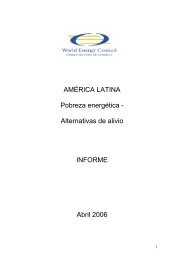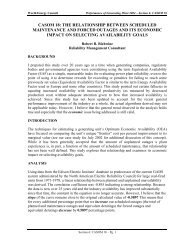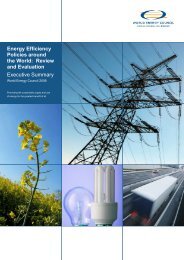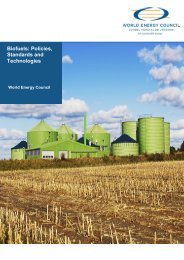Bioethanol – status report on bioethanol production from wood and ...
Bioethanol – status report on bioethanol production from wood and ...
Bioethanol – status report on bioethanol production from wood and ...
Create successful ePaper yourself
Turn your PDF publications into a flip-book with our unique Google optimized e-Paper software.
Fermentati<strong>on</strong> - The hydrolysate c<strong>on</strong>tains both 5-carb<strong>on</strong><br />
(pentose) <strong>and</strong> 6-carb<strong>on</strong> (hexose) sugars. The<br />
c<strong>on</strong>versi<strong>on</strong> of pentose sugars into ethanol is less<br />
efficient than c<strong>on</strong>versi<strong>on</strong> of hexose sugars. A system<br />
of mixed-sugar fermenting microorganisms is required<br />
to utilise the full range of sugars present <strong>and</strong> thus<br />
maximise the producti<strong>on</strong> of ethanol. Metabolic<br />
engineering is <strong>on</strong>-going to find low-cost,<br />
microorganisms capable of C5 <strong>and</strong> C6 sugar cofermentati<strong>on</strong><br />
that are also resistant to inhibitors (acetic<br />
acid, furfural) that may be present.<br />
Thermochemical<br />
C<strong>on</strong>taminati<strong>on</strong> <str<strong>on</strong>g>–</str<strong>on</strong>g> various comp<strong>on</strong>ents of the biomass<br />
feedstock can cause problems in the gasificati<strong>on</strong> <strong>and</strong><br />
catalytic synthesis stages. C<strong>on</strong>taminants such as tars<br />
<strong>and</strong> inorganic comp<strong>on</strong>ents (halides, alkalis, ash) present<br />
in the syngas can deactivate the catalysts <strong>and</strong> must be<br />
removed prior to catalytic c<strong>on</strong>versi<strong>on</strong>. The formati<strong>on</strong> of<br />
tars, <strong>and</strong> measures to deal with their removal, are<br />
significant challenges in biomass gasificati<strong>on</strong>.<br />
Advances in gas clean-up <strong>and</strong> catalyst preparati<strong>on</strong>s are<br />
also needed in order to make large-scale biomass to<br />
liquid facilities practical.<br />
ECONOMICS<br />
Both the biochemical <strong>and</strong> thermochemical pathways<br />
require sophisticated processing steps that have higher<br />
operating costs <strong>and</strong> need significant capital investment<br />
compared with grain-based ethanol processes. Based<br />
<strong>on</strong> the current state of technology, capital costs for<br />
biochemical cellulosic ethanol are estimated to be<br />
between US$4.03 <strong>and</strong> $5.60 per US gall<strong>on</strong> of annual<br />
capacity (8, 9). Operating costs are estimated to be<br />
between US$1.34 <strong>and</strong> $1.69 per US gall<strong>on</strong>, depending<br />
up<strong>on</strong> the assumpti<strong>on</strong>s made about feedstock costs,<br />
enzyme costs, <strong>and</strong> the kind of pretreatment to be<br />
employed (8,9). Projected capital costs for future<br />
plants employing anticipated improvements in<br />
biochemical c<strong>on</strong>versi<strong>on</strong> are estimated to be US$3.33-<br />
4.44 per US gall<strong>on</strong> ethanol annual capacity with<br />
operating costs dropping to US$0.40-0.89 per US<br />
gall<strong>on</strong> of ethanol (10). The US Department of Energy<br />
(DOE) has determined that competitiveness with<br />
petroleum can be achieved at an ethanol producti<strong>on</strong><br />
cost of US$1.07/US gall<strong>on</strong> (in 2002 dollars) <strong>and</strong> aims<br />
to achieve this goal by 2012 (5). This compares to the<br />
producti<strong>on</strong> cost of Brazilian sugarcane ethanol of<br />
US$0.81/gal.<br />
Lignocellulosic based ethanol has a further advantage<br />
over starch based ethanol in that the feed stock is not<br />
commodity based <strong>and</strong> subject to brokers <strong>and</strong> trader<br />
speculati<strong>on</strong> <strong>on</strong> pricing. Lignocellulosic based<br />
feedstocks avoid the arbitrage that starch-based ethanol<br />
is subject to; project developers are better able to<br />
forecast <strong>and</strong> manage feedstock costs reducing project<br />
risk. Many starch-based ethanol producers are<br />
currently struggling to survive <strong>and</strong> many may go<br />
bankrupt due to the volatile swings in corn, wheat,<br />
sugar <strong>and</strong> ethanol prices.<br />
A recent study of the producti<strong>on</strong> of Fischer-Tropsch<br />
(FT) liquids <strong>from</strong> syngas has shown the<br />
thermochemical platform to be ec<strong>on</strong>omically<br />
comparable to the biochemical platforms (8).<br />
CELLULOSIC ETHANOL PLANTS<br />
This secti<strong>on</strong> provides brief details <strong>on</strong> all publically<br />
announced <strong>bioethanol</strong> plants based <strong>on</strong> lignocellulosic<br />
feedstocks. The authors have endeavoured to be<br />
comprehensive but do not guarantee all facilities are<br />
included. Table 1 summarises all known facilities as of<br />
February 2009, <strong>and</strong> these are shown geographically <strong>on</strong><br />
Fig. 4.<br />
Table 1 Lignocellulosic Facilities as at February 2009.<br />
Pilot 1 /<br />
Dem<strong>on</strong>strati<strong>on</strong> 2<br />
Commercial 3<br />
Biochemical 25 9<br />
Thermo Chemical 5 3<br />
Note: 1. Pilot Scale is R&D<br />
2. Dem<strong>on</strong>strati<strong>on</strong> Scale is < 10 ML/yr<br />
3. Commercial Scale is > 10 ML/yr<br />
United States<br />
Currently the US has a target of 136,260 milli<strong>on</strong> litres<br />
per year (ML/yr) of renewable fuels producti<strong>on</strong> by<br />
2022. The US Renewable Fuels St<strong>and</strong>ard calls for<br />
60,560 milli<strong>on</strong> liters to come <strong>from</strong> lignocellulosic<br />
sources. The driving force for this requirement is<br />
primarily energy independence; however green house<br />
reducti<strong>on</strong> is a significant motivating factor for the<br />
inclusi<strong>on</strong> of lignocellulosic based fuel.<br />
Dem<strong>on</strong>strati<strong>on</strong>-scale cellulosic ethanol plants are under<br />
c<strong>on</strong>structi<strong>on</strong> as part of the government’s goal to make<br />
cellulosic ethanol cost competitive by 2012. The plants<br />
cover a wide variety of feedstocks, c<strong>on</strong>versi<strong>on</strong><br />
technologies <strong>and</strong> plant c<strong>on</strong>figurati<strong>on</strong>s to help identify<br />
viable technologies <strong>and</strong> processes for full-scale<br />
commercializati<strong>on</strong>. All dem<strong>on</strong>strati<strong>on</strong> plants, which are<br />
sized at 10% of a commercial-scale biorefinery, are<br />
expected to be operati<strong>on</strong>al by 2012. Commercial-scale<br />
plants are in the planning stages. Dem<strong>on</strong>strati<strong>on</strong> <strong>and</strong><br />
commercial plants include:<br />
• Abengoa - Abengoa is using a $76 milli<strong>on</strong> DOE<br />
grant to develop a 42 ML/yr of cellulosic ethanol<br />
integrated biorefinery, in Hugot<strong>on</strong>, Kansas. The<br />
biomass plant will be situated next to a<br />
c<strong>on</strong>venti<strong>on</strong>al cereal-to-ethanol facility to share<br />
feedstocks, including wheat straw <strong>and</strong> corn stover.<br />
Both enzymatic hydrolysis <strong>and</strong> gasificati<strong>on</strong> will be

















